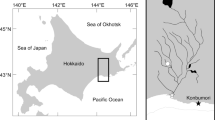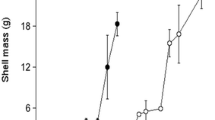Abstract
To restore the diminishing population of the giant clam Tridacna gigas in Sagay Marine Reserve (SMR), Negros Occidental, central Philippines, two size classes [8- and 10-cm shell length (SL)] of hatchery-bred T. gigas were reared in an adjacent ocean nursery for restocking to Carbin Reef later upon reaching grow-out size of ≥20 cm SL. Growth rates did not significantly differ for both sizes and were on average 0.67 cm month−1. However, survival after 382 days of rearing T. gigas was significantly higher in the 10-cm SL clams than the 8-cm SL clams (96 and 83%, respectively). For future restocking projects, the use of 8-cm SL clams is recommended because the lower survival of this size class is compensated by its cheaper price. While rearing the clams to attain grow-out size, the population of wild clams (Family Tridacnidae) in Carbin Reef was assessed using ten 50 × 2-m belt transects. Four species of tridacnid clams have been recorded: Hippopus hippopus, Tridacna crocea, T. maxima, and T. squamosa. T. crocea comprised 12.5–93.9% of all the clams observed in all ten transects. There was a significant difference in clam density between species (ANOVA, F = 6.94, P < 0.001), with T. crocea having the highest density. Living T. gigas were absent, but presence of dead shells was indicative of its presence in the reef in the past. It can be expected that the release of hatchery-bred T. gigas juveniles in Carbin Reef could provide future breeders that will repopulate this reef and the adjacent reef communities.






Similar content being viewed by others
References
Barker JR, Lucas JS, Nash WJ (1988) Comparative growth rates for Tridacna gigas at different localities in Northeastern Australia. In: Copland JW, Lucas JS (eds) Giant clams in Asia and the Pacific. Australian Centre for International Agricultural Research, Canberra
Beckvar N (1981) Cultivation, spawning, and growth of the giant clams Tridacna gigas, T. derasa, and T. squamosa in Palau, Caroline Islands. Aquaculture 24:21–30
Bell J, Nash W (2004) When should restocking and stock enhancement be used to manage sea cucumber fisheries? In: Lovatelli A, Conand C, Purcell S, Uthicke S, Hamel JF, Mercier A (eds) Advances in sea cucumber aquaculture and management, FAO fisheries technical paper no. 463. FAO of the United Nations, Rome
Bell JD, Lane I, Gervis M, Soule S, Tafea H (1997) Village-based farming of the giant clam, Tridacna gigas (L.), for the aquarium market: initial trials in Solomon Islands. Aquac Res 28:121–128
Bell JD, Rothlisberg PC, Munro JL, Loneragan NR, Nash WJ, Ward RD, Andrew NL (2005) Restocking and stock enhancement of marine invertebrate fisheries. In: Southward AJ, Young CM, Fuiman LA (eds) Advances in marine biology. Elsevier, San Diego
Bell JD, Bartley DM, Lorenzen K, Loneragan NR (2006) Restocking and stock enhancement of coastal fisheries: potential, problems and progress. Fish Res 80:1–8
Bert TM, McMichael RHJ, Cody RP, Forstchen AB, Halstead WG, O’Hop J, Ransier JM, Tringali MD, Winner BL, Kennedy FS, Leber KM, Neidig CL (2003) Evaluating stock enhancement strategies: a multi-disciplinary approach. In: Nakamura Y, McVey JP, Leber KM, Neidig C, Fox S, Churchill K (eds) Thirtieth U.S.-Japan meeting on aquaculture: ecology of aquaculture species and enhancement of stock, 3–4 December 2001. Sarasota, Florida
Blankenship HL, Leber KM (1995) A responsible approach to marine stock enhancement. Am Fish Soc Symp 15:167–175
Blidberg E (2004) Effects of copper and decreased salinity on survival rate and development of Tridacna gigas larvae. Mar Environ Res 58:793–797
Boglio EC, Lucas JS (1997) Impacts of ectoparasitic gastropods on growth, survival, and physiology of juvenile giant clams (Tridacna gigas), including a simulation model of mortality and reduced growth rate. Aquaculture 150:25–43
Bonham K (1965) Growth rate of giant clam Tridacna gigas at Bikini Atoll as revealed by radioautography. Science 149:300–302
Calumpong HP, Apao AB, Lucanas JR, Estacion JS (2002) Community-based giant clam restocking—hopes for biodiversity. In: Moosa MK, Soemodihardjo S, Soegiarto A, Romimohtarto K, Nontji A, Suharsono S (eds) Proceedings of the ninth international coral reef symposium, 23–27 October 2000, Bali, Indonesia
Crawford CM, Lucas JS, Nash WJ (1988) Growth and survival during the ocean-nursery rearing of giant clams, Tridacna gigas 1. Assessment of four culture methods. Aquaculture 68:103–113
Estacion JS (1988) Ocean-nursery phase for giant clams in the Central Visayas, Philippines. In: Copland JW, Lucas JS (eds) Giant clams in Asia and the Pacific. Australian Centre for International Agricultural Research, Canberra
Estacion JS, Braley RD (1988) Growth and survival of Tridacna gigas juveniles in an intertidal pond. In: Copland JW, Lucas JS (eds) Giant clams in Asia and the Pacific. Australian Centre for International Agricultural Research, Canberra
Gomez ED, Alcala AC (1988) Giant clams in the Philippines. In: Copland JW, Lucas JS (eds) Giant clams in Asia and the Pacific. Australian Centre for International Agricultural Research, Canberra
Gomez ED, Belda CA (1988) Growth of giant clams in Bolinao, Philippines. In: Copland JW, Lucas JS (eds) Giant clams in Asia and the Pacific. Australian Centre for International Agricultural Research, Canberra
Gomez ED, Mingoa-Licuanan SS (2006) Achievements and lessons learned in restocking giant clams in the Philippines. Fish Res 80:46–52
Gomez ED, Aliño PM, Yap HT, Licuanan WY (1994) A review of the status of Philippine reefs. Mar Poll Bull 29:62–68
Gomez ED, Cabaitan PC, Vicentuan KC (2006) Coral culture and transplantation and restocking of giant clams in the Philippines. In: Primavera JH, Quinitio ET, Eguia MRR (eds) Proceedings of the regional technical consultation on stock enhancement for threatened species of international concern, 13–15 July 2005, Iloilo, Philippines
Hart AM, Bell JD, Foyle TP (1998) Growth and survival of giant clams, Tridacna derasa, T. maxima and T. crocea, at village farms in the Solomon Islands. Aquaculture 165:203–220
Juinio MAR, Meñez LAB, Villanoy CL, Gomez ED (1989) Status of giant clam resources of the Philippines. J Mollus Stud 55:431–440
Klumpp DW, Bayne BL, Hawkins AJS (1992) Nutrition of the giant clam Tridacna gigas (L.). I. Contribution of filter feeding and photosynthates to respiration and growth. J Exp Mar Biol Ecol 155:105–122
Lucas JS, Nash WJ, Crawford CM, Braley RD (1989) Environmental influences on growth and survival during the ocean-nursery rearing of giant clams. Tridacna gigas (L.). Aquaculture 80:45–61
Mingoa-Licuanan SS, Gomez ED (2007) Giant clam hatchery, ocean nursery and stock enhancement. Aquaculture extension manual no. 37. SEAFDEC Aquaculture Department, Iloilo, Philippines
Nash WJ (1988) Growth and mortality of juvenile giant clams (Tridacna gigas) in relation to tidal emersion on a reef flat. In: Copland JW, Lucas JS (eds) Giant clams in Asia and the Pacific. Australian Centre for International Agricultural Research, Canberra
Okuzawa K, Maliao RJ, Quinitio ET, Buen-Ursua SMA, Lebata MJHL, Gallardo WG, Garcia LMB, Primavera JH (2008) Stock enhancement of threatened species in Southeast Asia. Rev Fish Sci 16(1–3):394–402
Pasaribu BP (1988) Status of giant clams in Indonesia. In: Copland JW, Lucas JS (eds) Giant clams in Asia and the Pacific. Australian Centre for International Agricultural Research, Canberra
Pauly D (1988) Some definitions of overfishing relevant to coastal zone management in Southeast Asia. Trop Coastal Area Manage 3:14–15
Poutiers JM (1998) Bivalves (Acephala, Lamellibranchia, Pelecypoda). In: Carpenter KE, Niem VH (eds) FAO species identification guide for fishery purposes. The living marine resources of the Western Central Pacific, volume 1. Seaweeds corals, bivalves and gastropods. FAO of the United Nations, Rome
Rosewater J (1965) The Family Tridacnidae in the Indo-Pacific. Indo Pacific Mollusc 1:347–396
Ruscoe EJ (1962) Some records of large Tridacna specimens. Hawaiian Shell News 11:8
Thomas FR (2003) ‘Taming the lagoon’: aquaculture development and the future of customary marine tenure in Kiribati, central Pacific. Geografiska Annaler 85B:243–252
Villanoy CL, Juinio AR, Meñez LA (1988) Fishing mortality rates of giant clams (Family Tridacnidae) from the Sulu Archipelago and Southern Palawan, Philippines. Coral Reefs 7:1–5
Acknowledgments
This project was funded by the SEAFDEC/AQD (Budget Code 5205-T-RD-FS0106) and the Government of Japan Trust Fund (Budget Code 8100-T-FD-FS0106). Field work in Carbin Reef was assisted by Joemel Sumbing, Silverio Tibudan of SEAFDEC/AQD, SMR staff, Sagay City LGU and the Bantay Dagat. The map was drawn by Isidro Tendencia of SEAFDEC/AQD. The manuscript was reviewed by two anonymous reviewers.
Author information
Authors and Affiliations
Corresponding author
Rights and permissions
About this article
Cite this article
Lebata-Ramos, M.J.H.L., Okuzawa, K., Maliao, R.J. et al. Growth and survival of hatchery-bred giant clams (Tridacna gigas) in an ocean nursery in Sagay Marine Reserve, Philippines. Aquacult Int 18, 19–33 (2010). https://doi.org/10.1007/s10499-009-9272-4
Received:
Accepted:
Published:
Issue Date:
DOI: https://doi.org/10.1007/s10499-009-9272-4




